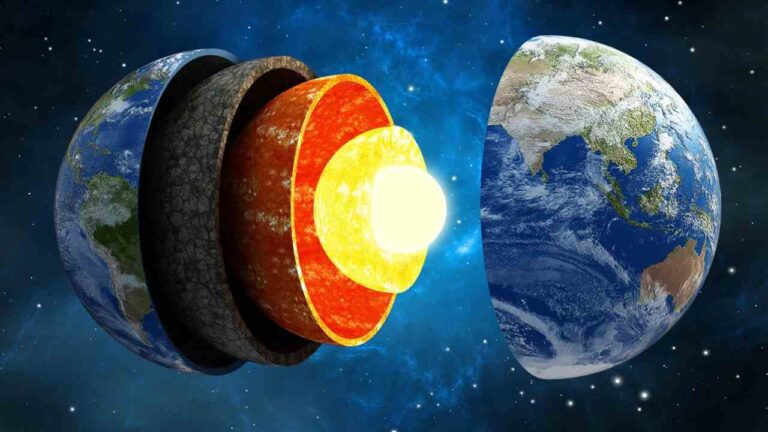A recent study proposes that the Earth’s core experiences a mysterious wobble approximately every 8.5 years.
Its structure is a cool thing and looks like a big terrestrial sweet, which is a jawbreaker or a round cake made of layers. The core is within the earth and acts as a reference to geological activities within and around the Earth.

The core consists of two distinct parts: an outer layer that is denser and partially liquefied, an intermediate layer that is comprised of molten liquid, and a central core that is mainly in a solid state. Interestingly, the inner core, mostly made up of iron and nickel, has a reduced radius to about 1200 kilometers. However, despite the heat it feel in the deep sea, the pressure at this depth keep the outer core in solid state.
It is the dynamism generated within the core that plays a significant role in the formation of Earth’s magnetic field. Since this layer is becoming colder and is growing thicker, it will radiate heat, and as the outer core will also start troubling the liquid metal. This process causes the formation of a dynamo effect which helps in the conversion of mechanical energy in to magnetic energy. The magnetic field created in the process shields the Earth from the dangerous solar radiation and loss of its upper atmosphere.
The key reason behind this is the fact that when it comes to analyzing the dynamics of the planet’s core, even the smallest shifts may lead to more apparent changes on the surface. For instance, walking or performing some tasks during our day can bend our spine and affect the length of the day slightly.
Inner Core Wobble: A Periodic Phenomenon
Recent research has revealed an intriguing aspect of the inner core’s behavior: Sometimes when they are jostled it wobbles. This wobble or fluctuation is not haphazard, but it has a rhythm and tends to occur in about 8. 5 years. This happened is referred to as the Inner Core Wobble (ICW).
In a way, the ICW is like a spinning top, turning slower and slower and closer and closer to falling down. On the other hand, the wobble of the Earth’s inner core is not arbitrary as a top is when it finally falls over but it is cyclic.
This wobble has important implications to the Earth interior and conflicts with the existing theories on the alignment and rotation of the Earth’s core and mantle.
Unraveling the Wobble: A Tilted Dance
The Inner Core West (ICW) is believed to result from a minor offset between the rotation axis of the inner core, and the mantle. This misalignment, referred to as static tilt, is believed to be about 0. 17 degrees.
The static tilt suggests that the north-western hemisphere of the inner core may be slightly denser than the balance. In addition, there is steeper density gradient between the inner and outer core mantle boundary.
People thought that the static tilt and the lack of equal density in the core contribute to the movement of the liquid outer core and, therefore, the field.
Observations and Analysis
It was first detected by scholars in the year 2019 after noticing that there was a cyclic variation in the polar motion, with it occurring over every 8 years. 5 years. This bizarre cycle prompted a further exploration of the forces at work in the heart of the planet we inhabit.
In further research, the existence of the ICW was once again observed as slight changes in 24-hour time were noted for the day globally. These variations were then compared to the earlier established oscillatory characteristics of polar motion.
Implications of the Inner Core Wobble
The discovery of ICW and the associated rigidity of inclination changes can therefore viewed as drawing major consequences to our understanding of Earth’s rotation as well as its relative density.
As you might expect from a body that is only seen periodically, ICW is the sort of thing that gives good restrictions for making a three-dimensional density model of the mantle, and that there is a noticeable increase in density at the boundary between the core and mantle. Naturally, these findings raise questions about prior understanding of how the Earth’s core and mantle are both aligned and rotating.
Furthermore, the approximately 8. Periodicity of ICW with a cycle of 5-years adds another element of variability to the Earth’s conditions. The oscillations, such as, imply a density change of δρ = 0. The density distribution along the radial direction includes 52 g/cm3 at the boundary of the inner core.
Future Research Directions
The inclusion of the ICW has implications for the future studies in the following ways:New goals include studying the layered structure and the density distribution in the core, patterns of core movements, and periods of activity.
This is where our technology and our knowledge of the earth is slowly advancing we can look forward to further insights into the very centre of the planet further insights into the driving forces that lie beneath us.
Conclusion
The Earth’s core is a realm shrouded in mystery and intrigue. The recent discovery of the Inner Core Wobble adds another piece to the intricate puzzle of our planet’s inner workings. As we continue to probe the depths of our planet, we inch closer to unraveling the mysteries of Earth’s geology and understanding the forces that sculpt our world.
Reference:Yachong An et al, Inner core static tilt inferred from intradecadal oscillation in the Earth’s rotation, Nature Communications (2023). DOI: 10.1038/s41467-023-43894-9.
Do not forget to share your opinion with us to provide you with the best posts !



0 Comments